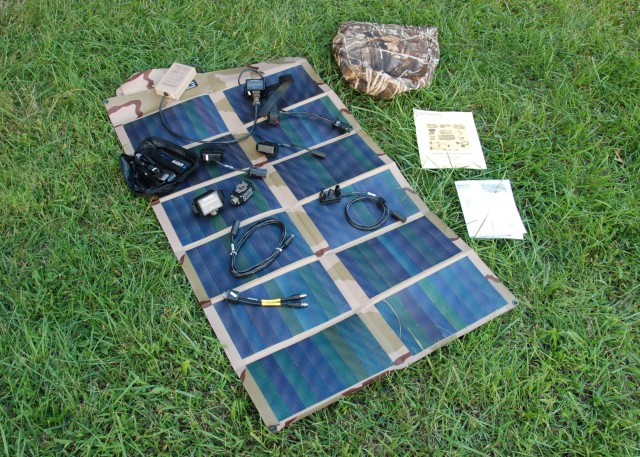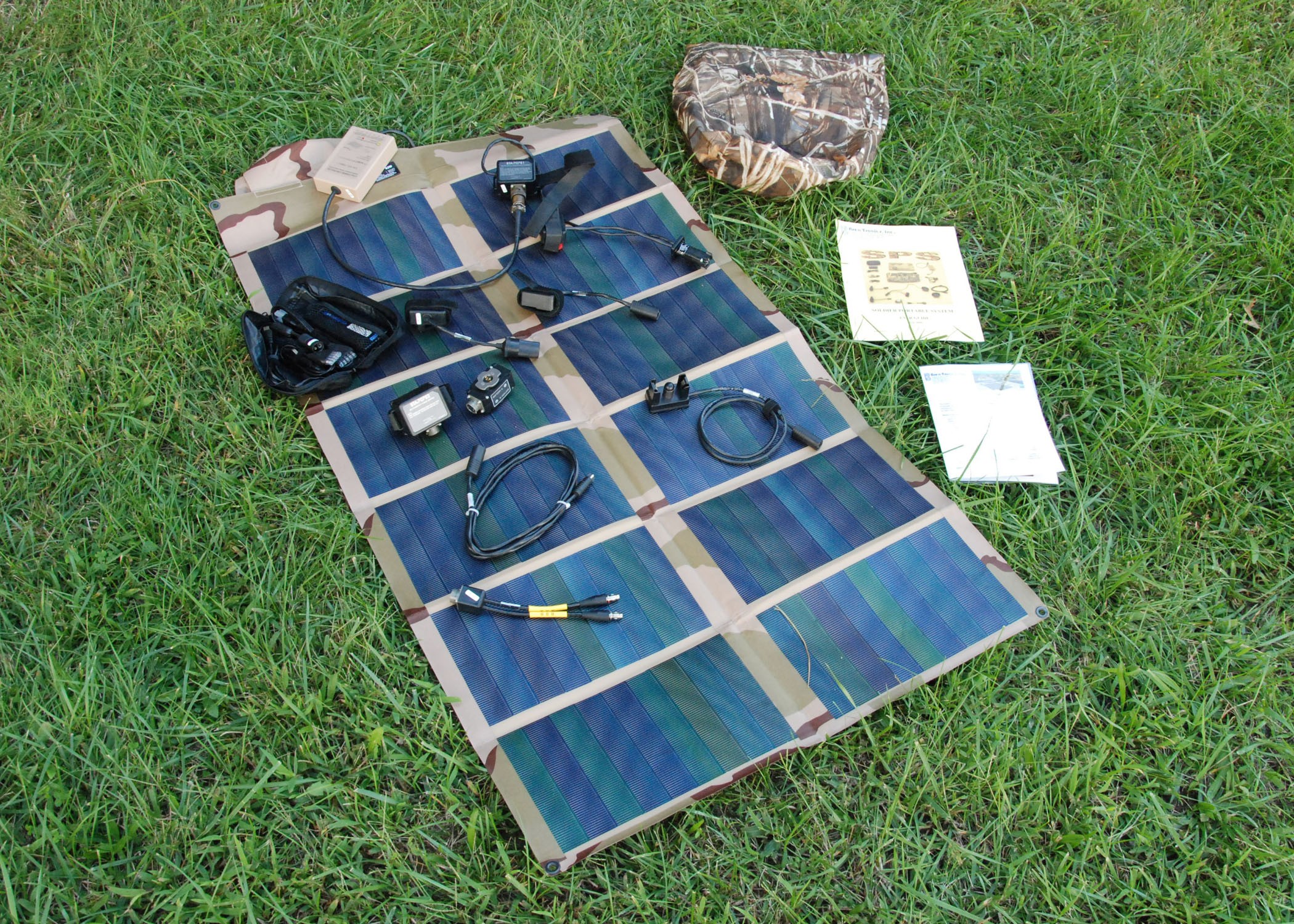WASHINGTON, April 26, 2011 -- Across the Army, teams of quiet professionals are lightening the load of Soldiers on the ground and introducing new energy efficiencies.
They are working to reduce the logistic burden of deployed Soldiers, shorten convoys and make contingency bases overseas and installations at home more energy and water self-reliant.
The Army is developing, piloting, testing and implementing new and emerging solutions that are reducing the Army's demands for electric power, fuel and water.
In some missions, Soldiers must carry over five pounds of batteries for each day of mission. The associated weight and transportation requirements for operational energy significantly reduce Soldier and unit mobility and endurance.
The Army's operational energy logistical tail is a handicap. In fiscal year 2010 the Army's fuel costs topped $2.7 billion, 70 percent of which was for theater operations. In Afghanistan, the military is enduring one casualty for every 24 ground resupply convoys. Between 70 to 80 percent of the resupply weight for those logistical convoys is composed of fuel and water.
At home, Soldiers live and train on installations dependent on vulnerable commercial power grids. Complex water and waste water distribution systems, price volatility and community compliance requirements present further challenges for Army commanders.
"Clearly, future operations will depend on our ability to reduce dependency, increase efficiency and use more renewable or alternative sources of energy. We've made great strides in this area and we intend to do more," Secretary of the Army John M. McHugh said during his posture hearing to Congress earlier this month.
Through a suite of energy initiatives, the Army is leveraging technology and enhancing operational performance across the range of military operations, addressing Soldier, platform and sustainment capability needs.
The end-state goal is greater operational effectiveness, measured in terms of endurance, agility, flexibility, resilience and force protection. We enable that through energy management, diversification, increased efficiency and demand reduction, leading to an affordable, sustainable force. The outcome is fewer Soldier casualties and energy dollars to reinvest in Soldier and Family Quality of Life.
The cornerstone of the Army's effort is its Net Zero Strategy. At home, this strategy is designed to guide installations to produce as much energy on site as they use, over the course of a year. This strategy is also being applied to water and waste on installations.
Net Zero's holistic approach is designed to appropriately steward available resources, manage costs and sustain Soldiers, families and civilians, thus ensuring tomorrow's Army has the same access to energy, water, land and natural resources as today's Army.
Assistant Secretary of the Army for Installations, Energy and Environment Katherine Hammack said, "Everything that we learn and implement in our permanent installations in regard to Net Zero operations can be leveraged into contingency base operations."
"We can take the lessons learned and transfer them to our warriors who are fighting in Afghanistan. Deploying new solutions to increase our energy efficiency, manage our demands and diversify our energy supplies are critical to the mission," Hammack said.
For deployed Soldiers, energy is essential. Energy and power enable our Soldiers to conduct continuous ground operations in remote areas over extended distances.
The battery power needed to support communications and small electrical devices is heavy. Studies show that it is hard for Soldiers to perform carrying more than 70 pounds, but today some Soldiers carry as much as 170 pounds. This situation also contributes to increases in stress injuries and longer-term medical problems.
The Army has already begun fielding energy-related Soldier systems to reduce weight and increase capabilities, such as the Rucksack Enhanced Portable Power System. REPPS is a state-of-the-art lightweight, portable power system capable of recharging batteries or acting as a continuous power source.
One hundred systems have been delivered to units supporting Operation Enduring Freedom, including the 86th Infantry Brigade Combat Team from Vermont , 1-172 Cavalry "Gypsies," 173rd Airborne Brigade "Sky Soldiers," 1-4 Infantry Brigade Combat Team, and the 2/2 Stryker Cavalry Regiment "Dragoons." Another 700 system will be available for issue this summer, officials said.
The Army is on track to field a new family of tactical generators, the Advanced Medium Mobile Power Sources family, or AMMPS, starting in 2012. The generators, ranging in size from 5 kW to 60 kW, use an average of 20 percent less fuel than the current sets in the field. Depending on the annual hours of operation, these sets can pay for themselves with fuel savings in one to two years.
In February, Hammack visited selected bases in Iraq, Afghanistan and Qatar to see firsthand the environmental and operational energy issues and challenges associated with contingency base operations.
"At our existing forward operating bases, we continue to look for new and efficient ways to expand the use of solar power, turning waste to energy, reuse of grey water such as reusing shower water for toilets, using waste heat for steam to electricity generation, solar hot water, micro power grids and other technologies to reduce the demand for resources," she said.
She said she found people taking initiative and making a difference.
"One example is a contractor filtering used generator oil and used canola oil from dining facilities to blend with JP8 fuel to run their generators. This reduced the amount of fuel transported and saved 65,000 gallons of JP8 last year. I also saw solar panels being used to provide power to perimeter force protection sensors, alert devices (big voice) and for perimeter lighting at Bagram (Airfield), Afghanistan."
Hammack also noted, "In Afghanistan foam tents are evident. Foam is great insulation but difficult to move or dispose of." She said, in the near term we have approximately 300 insulated tent liners in production for deployment to Afghanistan in support of a specific request from the United States Army Central Command and United States Forces Afghanistan.
Several tent-shading products have demonstrated they can reduce energy requirements and are now deploying a few of these systems for further evaluation.
"We continue to look for and acquire better tent and insulating technology," she said.
The Army is deploying the Tactical Fuels Manager Defense, an automated fuel inventory management system that is configured to enhance fuel accountability procedures in a tactical environment. Additionally, TFMD provides enterprise-level asset visibility of fuel operations and reports in theater to senior Army leadership.
The tailored reports will be useful in defining trends in consumption and detection of waste, fraud, and abuse. Automated inventory management, enterprise asset visibility, theft deterrence, and business process improvements will lead to more effective fuel management practices.
The "Iron Rangers" of the 1/16 Infantry Battalion, 1st Infantry Division will receive a variety of expeditionary, Soldier portable power systems during their deployment to Afghanistan this year. Beyond reduced volume and weight, these rucksack-portable systems provide individual to platoon-size energy and battery-charging capabilities using solar, methanol, or locally purchased propane. In addition, a pocket-sized power converter device allows Soldiers to use nearly any source of available power.
Smart and Green Energy for Base Camps, or SAGE, is an Army initiative to demonstrate a smart electrical micro-grid design for medium-sized Forward Operating Base camps and will be scalable to accommodate from 150 to 2,400 personnel.
The smart micro-grid represents an integrated, open-source approach for improving the generation, storage, distribution and management of electrical power at deployed locations, which typically rely on generator sets for electricity. It will enable generator support to a larger grid instead of single end users.
This holistic approach is expected to reduce fuel consumption by about 30-60 percent relative to current usage baselines and includes sensors and control systems, energy storage, energy-efficient structures and renewable sources.
The Army is also partnered with the Assistant Secretary of Defense, Operational Energy Plans and Programs to deploy a 1-megawatt micro-grid from the National Training Center, Fort Irwin, Calif., to Afghanistan. It is scheduled to be installed and operational before June 30.
This micro-grid was a centerpiece in the just-completed three-year Net Zero Plus Joint Capabilities Technology Demonstration that validated demand-reduction and supply-side technologies. The micro-grid supported seven National Training Center training rotations and functioned without fault for more than 2,000 hours in an environment similar to Afghanistan: dusty, windstorms, and temperatures ranging from 35-degrees to 117-degrees Fahrenheit.
The deployment to Afghanistan is designed to demonstrate to warfighters that micro-grid technology is available and ready, and will be a catalyst for detailed discussions on requirements and specifications.
"We are working on coordinating deployment of efficient generators and power distribution. Continuing development of hardware, software and controls to perform micro-grid implementation is underway for buildings at the Field Artillery Training Center at Fort Sill, Oklahoma. This technology also has potential use in a deployed operational environment," Hammack said.
Holistic policies are accelerating energy, environmental and efficiency solutions and technology for Forward Operating Contingency Bases. Charged with developing and implementing those policies, Hammack said, "Improving efficiency at base camps represents one of the best opportunities to decrease Army operational energy usage."
The Army realizes that energy use in peacetime and on installations differs from the energy use during contingency operations. Nonetheless, Hammack says, solutions at home will help Soldiers in combat.
"We are moving forward by developing new doctrine and focusing investment on technologies applicable in the context of contingency operations. These efforts can increase Soldier effectiveness, extend the endurance and resilience of the force, reduce the need for fuel convoys, and reduce operational costs."
The Army recently announced selection of installations that have committed to achieving Net Zero in Energy, Water or Waste. Five installations were identified in each of these areas and will communicate their journey to Net Zero on a regular basis.
This work is providing the critical data necessary to support initiatives which will address the operational energy challenges and maintain an efficient, flexible energy posture that will enable highly effective, widely dispersed, and increasingly mobile forces in combat.
Hammack said that through innovation, adaptation, exploration and evaluation.
"We are creating a culture that recognizes the value of sustainability, measured not just in terms of financial benefits, but benefits to maintaining mission capability, quality of life, relationships with local communities and the preservation of options for the Army's future," she said. "It is operationally necessary and financially prudent."
Related Links:
Army evaluating transportable solar-powered tents
Army launches "Net Zero" pilot program
Army seeking "frank" Soldier feedback on power sources
Army.mil: Science and Technology News
STAND-TO!: Army Energy Security
Assistant Secretary of the Army for Installations, Energy and Environment - ASA&E;




Social Sharing